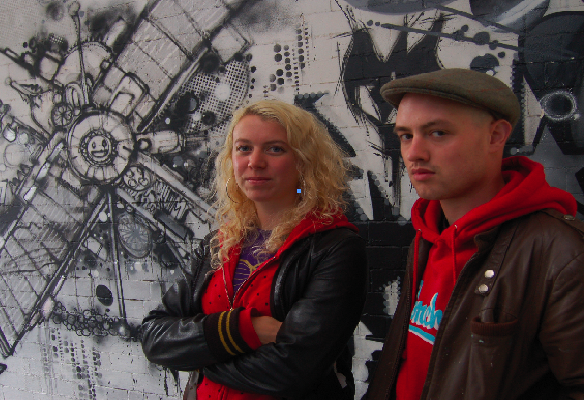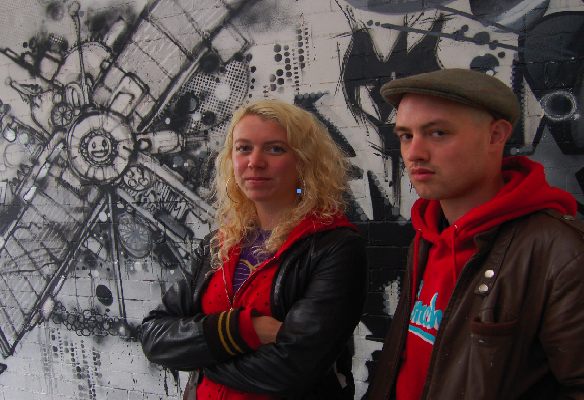 In a year the Recoat Gallery has snowballed from its West End corner to become a hub for Scotland’s graffiti and ever blossoming street art scenes. Gum met with owners Amy and Ali to find out how these artists got to where they are and learn where they hope to go.
In a year the Recoat Gallery has snowballed from its West End corner to become a hub for Scotland’s graffiti and ever blossoming street art scenes. Gum met with owners Amy and Ali to find out how these artists got to where they are and learn where they hope to go.
––––––––––––––––––––––––––––––––––––––––––––––––––––––––––––––––––––––––––––––––––
Friday is fast becoming Saturday and the smell of spray paint lingers at 323 North Woodside Road. An enthusiastic yet subdued crowd stare into a torch lit alley way but passersby seem somewhat bemused by the spectacle.
I grow acutely aware of the ever increasing strength of the fumes as I wriggle and excuse my way to the front of the late night throng – and the reason for this noire affair? A birthday party of course. Yet unlike most one-year-olds the Recoat Gallery was not content to allow its first anniversary to be defined by teddy bears and kisses from an army of aunts. Instead it flew in some of the UK’s best graffiti talents, hosted a late night live paint, held a ground-breaking exhibition of Scottish and global talent and gave out free beer – hazza.
I return to the gallery the following week to meet with Ali and Amy, a couple addicted to street art and graffiti culture that effortlessly exude its style and craft. The live paint is still on my mind so I begin by asking how such an event came to materialise.
“Scot Wilson is a manager at Manifesto Clothing in Dundee”, begins a softly spoken Amy. “He is famous for being a collector of street wear stuff and Ali knew him loosely so we asked him if he would like to co-curate a show with us. He agreed and decided to put together an exhibition of the friends he has met along the way. We were very lucky to have work by Fatsarazzi, Futura and Dave White and Jahan. Red Bull also supported the event and paid for three artists to come up from London. It went really well”, concludes Amy with an obvious sense of pride.
A gallery dedicated to street art and graffiti is somewhat new in Scotland, with Ali and Amy being the proud owners of Scotland’s first dedicated space. “How did you come to open the gallery?” Again Amy is the first to speak. “We had seen galleries like this in London and Melbourne but Scotland was missing out. We live very close to what is now Recoat and one day we noticed that it had a to-let sign on the window.” Ali quietly sits listening at his desk, a delicate ecosystem of letters, scrap paper and spray paint cans. I notice he is absentmindedly doodling a bubble letter on a bill as he listens to his partner.
“Ali had always wanted to open up a place called Recoat and suggested that we check it out”, continues Amy. “We set up the gallery to promote Scottish artists work, there is so much talent here and so as we could bring exciting graffiti and illustration artists to Glasgow and let Scottish people see their work. That way the scene can improve and we can help to inspire – the kids do seem to be responding.”
Suddenly Ali cuts Amy off, gesticulating mock quotation marks in the air as he does so. “For want of a better phrase ‘keeping it real’ is quite high on our list of priorities.” Amy laughs and picks up her sentence. “Once you start selling out you lose what you were trying to do in the first place. We wanted to make owning art more accessible but this is our livelihoods, we also need to make money.”
“I can’t believe that we have work by Crash and Daze” adds a wide eyed Ali. “They are early early New York pioneers who started the scene and we have their work hanging on our wall. We also have work by guys like SHEONE and O. Two from the live paint, real ground breaking UK artists who have come up and got involved with our years anniversary celebration.” Ali’s excitement is justified as his name drops are those of some of the global graffiti scenes most important trail blazers and brightest talents.
Outside talents aside, I ask how they feel about the current Glaswegian graffiti scene and unsurprisingly Ali is the first to answer.“It has got a good structure that has kept going in Glasgow while other cities have not been so lucky. There are guys that do amazing pieces and if there were more legal walls people would be able to appreciate the talent in the city.” “There is also a whole new generation coming through”, adds an excited Amy. “They are the age that Ali was when he started so that makes them the third or fourth generation of Glaswegian graffiti artists.”
During the 1990s Glasgow City Council once supplied graffiti artists with spaces to create their art without fear of breaking the law, aka a free wall. However the graffiti eventually moved from the legal to the surrounding illegal spaces as artists battled to outdo each other. In response the Council shut down all the free walls.
“There will always be people who are as much into painting as they are into tagging and bombing”, highlights Amy. “That is the way it is in Scotland but Glasgow clearly wants to be perceived as having shed its rough image. The council do not want people going through Charing Cross and seeing graffiti like it was back in the day, so the graffiti has gone underground. Yet, if you open up the city, as has been done in San Francisco or Melbourne then you get graffiti everywhere and it can make a city famous.”
The Council’s distain for graffiti has thawed as of late and they have even recruited Sam Bates, an Australian graffiti artist famed for his photo real work, to produce a series of murals for the Commonwealth games. Another finger twitching move took place last year when Glasgow Underground approached Recoat with the proposition of allowing a group of graffiti artists to paint a mural at the SPT Underground Festival.
The impressive finished product was a collaborative piece from Ali, Amy, Sam Bates, Rogue, EJEK and the Edinburgh artist Elph. “Who approached who?”“Back int day”, jokes Ally in his best Yorkshire accent, “that used to be one of the halls of fame. We knew the PR Company doing the Subway festival and they asked us if we wanted to do anything with the space and we did.”
Local reaction was positive with other artists, residents, SPT workers and passersby all voicing their approval, though one elderly resident was not so elated. “Is it true that an old woman gave you abuse while you were painting?”
“Dogs abuse”, answers Ally, casting a wry smile my way. “She was shouting at Elf, screaming ‘you are not even young, you are not even a wee boy, what the fuck are you doing?’” I cannot help but laugh. “We had a sound system and drummers, the works”, adds Amy “But there must have been some confusion between the residents and the council but it was all above board, we even had the permission of the shop who owned the wall.” Ali is keen to highlight that he hopes Kelvinbridge was only the start
“We are slowly trying to edge towards the idea of those walls being back in public and show that it is possible for walls to be managed and maintained – it is tiny steps though.” “So do you think what has happened in Glasgow has had a significant effect on the health of the Scottish scene?” I reply.
“Duncancumming.co.uk and scottishgraffiti.blogspot.com are good indicators of the strength of the scene as they contain thousands of pictures that have been taken across the whole of Scotland. Lots of people send their photos to the site and it has become a real hub for the scene and the forums allow artists to communicate with each other”, clarifies Amy.
“Scotland has lots of different levels of graffiti and this gallery is a new step for the whole street art movement,” continues Ali. “Analogue books in Edinburgh were an inspiration to us to set up Recoat. They hosted some graf before we did but it was not a dedicated space in the same way we are.”
In certain circles the concept of a ‘graffiti gallery’ is regarded as an oxymoron, yet more and more are springing up across the world. Despite this new direction early artists such as KaySlay argue that legal graffiti is a paradox and graffiti is only genuine if done on a train or on public property. I put this question to the Recoaters.
Amy is first to respond, though Ali is clearly eager to give his view as well. “I would describe that as semantics. Graffiti, street art, bombing, stencils – those are just words. The people who struggle with it are the purist graffiti artists. Even the guys who started back in the day have always struggled with this. Do you sell out if you sell your work? I think that is something that every artist struggles with.”
“People say that it is vandalism but there is a creeping change where people say ‘I know it is illegal, but oho isn’t it cool’”, she continues. “For example, many of our customers say ‘so this is graffiti, just like Banksy but most artists are nothing like Banksy. Art should be accessible and it should not be an elite pass time to make it or own it. I do not see how it matters where the art is, if a piece is good then that should be all that matters.”
“I have always thought it was a bizarre thing, what is cool about working in the Co-Op for 40 hours a week and never achieving anything”, concludes Ali. “Why is that better than making a living out of being creative? Don’t waste your time in a shit job wasting your time and your talent.”
The Front Row, a couture fashion inspired exhibition, opens on the 10th of October 7-10pm. There will also be a bargain show on 14th of November 7-10pm with all pieces under £40. Recoatdesign.com

